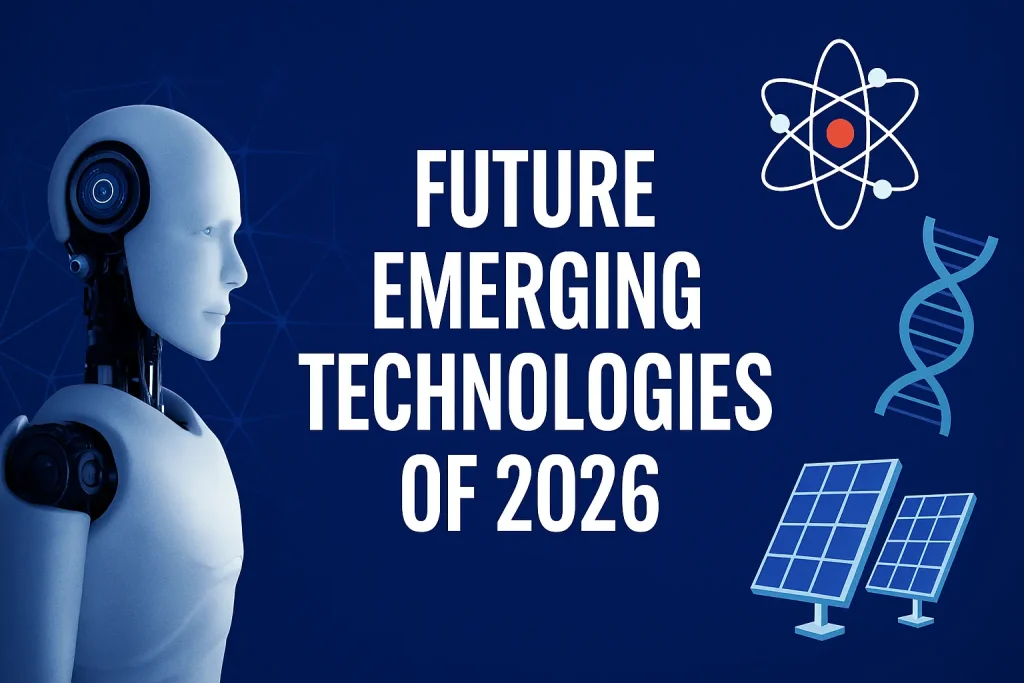The emerging technologies of 2026 are new innovations that are expected to be tested, launched, or used widely by 2026. These technologies will appear in fields like AI, computing, energy, transport, space, and communication networks.
Experts at McKinsey & Company believe AI-based technologies will lead industrial change. These include autonomous systems, human–machine teamwork, and edge AI. They will be the main drivers of progress during this period.
Quantum computing is also developing quickly. Companies like IBM aim to achieve practical quantum results by 2026. This progress could help industries such as materials research, finance, and drug discovery make big advances.
In the energy and mobility sectors, solid-state batteries will reach the testing phase by 2026. These batteries will charge faster and store more energy. They will help make electric vehicles more efficient and powerful.
Let’s explore these future emerging technologies of 2026 in detail!
Future Emerging Technologies of 2026
Future emerging technologies of 2026 are new smart tools which include advanced AI, faster networks, and powerful systems. They will change how we live, work, and make the world more connected.
1. Artificial Intelligence
Artificial intelligence (AI) is the imitation of human intelligence in machines. These AI systems are designed to perform certain tasks which normally require human intelligence. These tasks include understanding language, recognizing images, making decisions or solving problems.
In this context, we are discussing AI-Based Emerging Technologies which will make the next wave of AI tools and systems. They go beyond what is currently existing and are becoming smarter and more autonomous.
Generative AI 2.0
Generative AI’s first generation could generate text or images using simple prompts. Generative AI 2.0 will be the next multimodal version. It will handle images, audio, and text together and be more autonomous. These systems can act on their own. They combine reasoning, planning, and creativity. Research and trend forecasts show that generative AI will be more deeply integrated into business workflows and creative systems by 2026.
Predictive AI in Healthcare
Predictive AI models in healthcare will go beyond analyzing past data. They will begin anticipating disease before symptoms appear. For example, AI systems may detect early signs of cancer and heart diseases by using imaging scans plus patient history. This means faster interventions and better outcomes.
Edge AI Chips
Traditional AI relies heavily on cloud servers. Edge AI brings computation right to devices. These devices include smartphones, wearables, or vehicles. These chips can process data locally. This reduces latency and improves privacy. It also unlocks intelligent features even offline. For instance, a smartphone with an edge AI chip could run real-time image recognition, voice assistants without constant internet access. Startups are already developing new edge AI solutions for 2026.
Futuristic Tech Examples of AI
Some futuristic tech examples you may see by 2026 include:
Neuroadaptive AI Tutors That Read Your Brain Signals
Researchers are developing AI tutors that don’t just see your answers but they measure your engagement in real time using brain signals (EEG) and adjust teaching style accordingly. This is called “neuroadaptive tutoring.” If your brain shows confusion, the tutor simplifies the topic; if it shows you’re bored, it introduces more challenging content. It’s a futuristic tech example that merges generative AI with neuroscience.
Smart TVs That Observe & Interact Like Companions
In the near future, your TV may not just stream shows. It might watch your moods and respond. Samsung has already started evolving TVs into “intelligent companions” . These companion devices can monitor rooms, alert you of changes, or interact with other smart devices. For instance, the TV could notice when you leave the room and dim lights, or pause a show when someone enters.
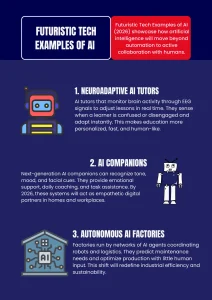
2. Quantum Computing and Edge Intelligence
Next-generation technology means computing that goes beyond the binary, cloud-only model. Two tracks lead this shift by 2026: quantum computing and edge intelligence (AI processed on local chips instead of distant servers).
Quantum Computing
IBM is rolling out its modular Quantum System Two data-center architecture and publishing a path to fault-tolerant machines, with new centers and hardware coming online through 2026. A fault-tolerant machine is a computer system especially in quantum computing that continues working accurately even if some components or qubits fail, by automatically detecting and correcting errors.
These systems aim to move from “demo” runs to useful, error-managed workloads in areas like materials, finance, and drug discovery. Google’s Quantum AI group has published a roadmap focused on building logical, error-corrected qubits, and has reported chip-level progress that reduces errors as devices scale—steps needed for practical applications.
On the software side, Amazon Braket already gives developers managed access to multiple quantum hardware types (superconducting, trapped-ion, neutral-atom) and recently introduced features to run programs faster, making hybrid quantum-classical R&D easier. Because powerful quantum computers could threaten today’s encryption in the future, standards bodies are already deploying post-quantum cryptography to keep data safe.
Edge Intelligence
AI will move closer to users in 2026 through edge AI chips in phones, vehicles, and IoT devices. Local processing reduces latency and bandwidth use. It also improves privacy. Industry reports show that companies are quickly starting to use this technology between 2025 and 2026.
It is growing as part of the upgrades to 5G and 5G-Advanced networks and the setup of MEC (multi-access edge computing), which allows data to be processed closer to users for faster and smoother performance.
By the 2026 future, early advances are expected in quantum and edge technology. They are expected to shorten R&D cycles. This means faster simulations and faster testing. Together, these form the core next-generation technology stack for the coming decade.
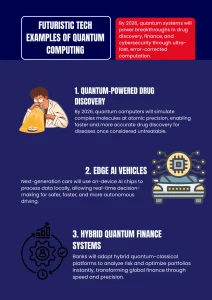
3. Biotechnology and Human Augmentation
Biotechnology and human augmentation combine biology, computing, and AI. Let’s discuss them in detail!
AI-Powered Genetic Editing
AI-powered genetic editing is one key area. Tools like CRISPR and its next versions like base editing and prime editing allow precise DNA modification. The CRISPR therapy Casgevy is already FDA-approved. It treats sickle cell disease and beta thalassemia. Currently, over 250 gene editing clinical trials are active in 2025 which can come to mainstream as treatment of many diseases in 2026. Now, the most recent version of CRISPER therapy like CRISPER-X, may allow editing in living tissues. These new version are more precise and have less side effects.
Neural Interfaces and Bionic Prosthetics
Neural interfaces and bionic prosthetics are the devices that connect your brain or neural signals to external hardware. As a result, these prosthetic robotic devices ( like prosthetic arms or other limbs) get controlled simply by your neural signals. For example, if you just think of moving the arm, your robotic arm will move just by detecting your thoughts through brain electric potential and signals. Researchers are combining AI with neuromorphic hardware and brain–computer interface (BCI) systems. This creates more natural movement. It provides sensory feedback and gives machine intuition.
Digital Twins in Medicine
Digital twins in medicine provide virtual replicas of a person’s organs, systems, or biology. These twins receive real-time data (like imaging, biomarkers, wearable sensors) and simulate responses to treatments. Doctors can test therapies virtually before using them on real patients. For example, Stanford scientists built a digital twin of a mouse brain that predicts neuron responses; a first step toward modeling human brains. Soon in 2026, patient twins may simulate how your heart or liver will respond to drugs or surgeries.
Futuristic Tech Examples related to Biotech
Mind-controlled prosthetic limbs move naturally. They provide real sensory feedback. Researchers are testing advanced BCI systems at Johns Hopkins and the University of Pittsburgh. These systems let users control robotic arms with thought. They can even “feel” pressure or texture through nerve stimulation.
Medical nanobots are another example. They are designed to travel inside the human body. They can repair damaged tissues. They can deliver drugs directly to target cells. Trials show their potential in several areas like targeted cancer therapy and regenerative medicine. Nanoscale robots could one day clear blocked arteries and destroy tumor cells with high precision.
Neural implants that enhance memory or restore lost functions. Startups like Neuralink and Synchron are developing minimally invasive brain implants that may help people with paralysis communicate or regain motor skills and could later be used to support cognitive enhancement and memory recovery.
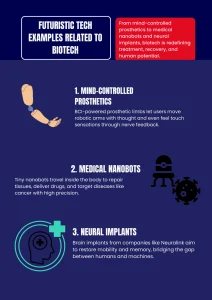
4. Green Energy & Climate Tech
Green energy and climate tech are becoming central to new technology. This is because the world is moving toward net-zero goals. By 2026, several groundbreaking innovations are expected to reach early deployment or pilot phases.
Solid State Batteries
Currently, batteries are based on liquid electrolytes but in 2026 solid state batteries will replace them. These batteries use solid material instead of liquid electrolytes. The use of solid material in batteries improves safety, energy density, and longevity. According to TrendForce, solid state batteries have passed the testing stage and their pilot production for EVs are speeding up in the U.S. and Europe. First mass production is expected as early as 2026. Stellantis and Factorial Energy have tested automotive-size solid-state cells. These cells can charge from 15% to 90% in 18 minutes.
Carbon Capture & Storage
Carbon capture & storage (CCUS) and direct air capture will be more widely integrated into industrial operations and power plants. Countries aiming for carbon-neutral status will rely on these technologies. Carbon capture & storage (CCUS) and direct air capture will offset hard-to-eliminate emissions by 2026.
AI-optimized Solar Grids
AI-optimized solar grids will manage energy sources with intelligence. They will balance supply and demand in real time. They will forecast energy generation. They will direct power where it is needed most. Smart inverters and predictive maintenance, and AI control systems will turn solar farms into self-regulating networks.
Hydrogen-powered Transport
Hydrogen-powered transport will grow further, especially fuel cells. Hydrogen trucks, buses, and even trains will begin pilot services particularly in regions investing in hydrogen infrastructure. Green hydrogen produced using renewables will become more cost competitive.
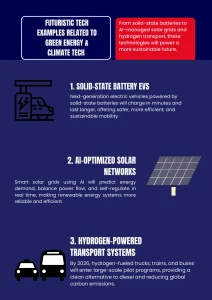
5. Space Technology and Advanced Robotics
Space exploration and robotics will be essential in the 2026 future. They will push humanity outward and refine autonomous systems here on Earth.
NASA’s Artemis II
NASA’s Artemis II mission is targeted for 2026. It plans to send astronauts on a lunar flyby to test deep-space systems. It paves the way for future lunar bases. Axiom Space is developing commercial space stations. It is creating modular habitats for research, tourism and industry beyond low Earth orbit.
AI-powered Maintenance Robots
In robotics, AI-powered maintenance robots and Humanoids are also expected. They will work in harsh environments like space stations or lunar surfaces. They will perform inspections, repairs and will also do assembly tasks. These systems will use machine learning to adapt to changing conditions autonomously.
Autonomous Drones
Autonomous drones will be used for exploration. They will map planetary surfaces, scout terrain, and will support mission logistics. Small robotic scouts could explore certain areas like caves and craters. They could even explore subsurface structures before humans arrive.
Futuristic Tech Examples related to Space Technology and Advanced Robotics
Futuristic tech examples include space-mining prototypes, AI navigation bots, and interplanetary internet. Space-mining prototypes extract resources from asteroids or moon surfaces. AI navigation bots chart optimal paths in space. Interplanetary internet systems use laser communications. These innovations are the boldest futuristic tech examples of our era.
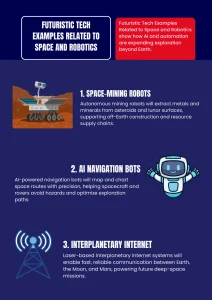
FAQs about Future Emerging Technologies of 2026
How Emerging Technologies Shape the Future of Work?
Emerging technologies are changing the workplace. They mix human skills with machine AI. AI and automation handle repetitive tasks. This lets people focus on creativity and problem-solving. Companies are moving to flexible, AI-driven teams. This defines a new era of productivity.
How Emerging Technologies Will Impact Careers in the Near Future?
Technology will quickly change job roles. This is especially true with Generative AI and automation. Demand will grow for professionals with digital skills. Examples are AI trainers and data analysts. Workers will succeed if they combine technical skills with adaptability. Emotional intelligence will also be key in this new economy.
What are the future Trends of Emerging Technologies?
Future technologies will focus on certain systems. These systems are intelligent and sustainable. They are also human-centered. Key trends include agentic AI. This AI makes autonomous decisions. Bioconvergence is another trend. This mixes biology and data science. 6G networks are also a trend. These innovations will create a connected ecosystem. This ecosystem is predictive and responds to human needs.
How Will AI-Based Emerging Technologies Change Our Daily Lives by 2026?
By 2026, AI will make daily life more personalized. It will also make it more seamless. Smart homes will adjust automatically. AI companions will manage tasks and schedules. Predictive healthcare comes from wearables. Safer autonomous vehicles will also be used. All these will enhance comfort and well-being.
Why 2026 Is Important for Next-Generation Technology?
The year 2026 marks a key moment. Major technologies will begin to converge. AI maturity and 6G research will work together. Quantum computing, biotech, and clean energy will also start to work together. This speeds up innovation. It turns theories into real-world applications for a smarter future.

